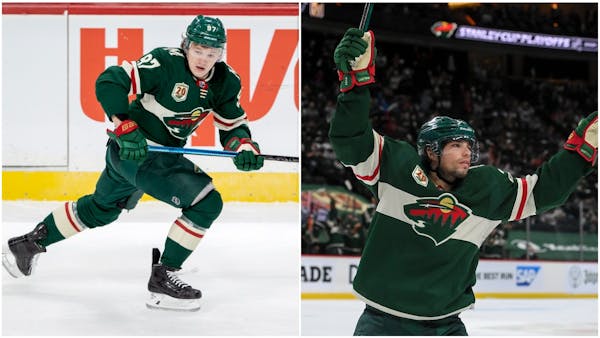Experienced players with contracts to match are still leading the Wild, but a youth movement could be on the horizon.
After buying out Zach Parise and Ryan Suter last week, the Wild is facing a future with limited financial flexibility that could make roster renovations a challenge in a year or two.
That's when the team might have to integrate more youngsters on entry-level deals into its lineup, and the Wild can load up its pipeline with new prospects starting Friday during the NHL draft, where it has not one but two selections in the first round.
"We're very comfortable where we are," General Manager Bill Guerin said. "To have two first-round picks this year is a good position to be in."
The Wild holds nine selections overall, including five in the first three rounds — this after drafting just five players overall last year. Rounds 2-7 are Saturday.
Headlining the pack of picks are No. 22 and No. 26 from Pittsburgh as part of the Jason Zucker trade from two seasons ago. Technically, these selections will represent the 21st and 25th players taken in the first round since No. 11 is forfeited by Arizona for violating the NHL's combine testing policy last season.
Only once in the Wild's history has the team drafted twice in the first round, in 2011, and the Wild could trade one or both to change its draft order. But Guerin made it clear the team won't "chase" the possibility.
"If there's something that makes sense where we can move up or move back, we'll do it," he said. "We're pretty flexible. We're an open-minded group that we'll listen to anything."
For now, the Wild's draft board is set and while there's room for debate — especially in a virtual draft like this where teams have their own quarters instead of huddling on the same arena floor — the target is to acquire talent.
"The best player available is going to be the biggest need," said the Wild's director of amateur scouting Judd Brackett, "someone who can impact a game — whether it be a puck-moving defenseman, whether it be a starting goaltender or a top-flight forward. We still want to get great players."
Last year, the Wild addressed its lack of depth up the middle by taking three centers with its five picks including Marco Rossi at ninth overall.
Having the top player available also fill a position of need is the ideal scenario, but Brackett pointed out that what the roster is missing now might be different when a drafted player is ready to debut. And concentrating on a position could lead to overlooking a more impactful player.
"We expect to find players and players that are going to help contribute and help the Minnesota Wild win," Brackett said.
Considering the range of talent in the first round, various skill sets could be in play for the Wild.
Michigan defenseman Owen Power is the consensus No. 1, with other standout defenders including Luke Hughes and Brandt Clarke. Forwards Matthew Beniers, Mason McTavish and William Eklund are also highly touted. Same with goalies Jesper Wallstedt and Sebastian Cossa.
Buffalo has the No. 1 pick with Seattle sitting second and Anaheim rounding out the top three.
Right winger Nikita Chibrikov, center Fedor Svechkov and defenseman Daniil Chayka are some of the players the Wild might be able to snag at 22 and 26.
"Goaltenders, power play defensemen, size defensemen, some centers, some pure goal scorers — I think this draft has a little bit of everything," Brackett said. "That's always what's going to lead to some unpredictability."
What could also cause uncertainty is the effect the COVID-19 pandemic had on prospect leagues and teams' ability to scout.
While the Western Hockey League had an abbreviated schedule, the Ontario Hockey League didn't play at all. The USHL had close to a normal schedule, as did college hockey. But some players were in new situations, getting loaned to Europe.
And scouting live wasn't always an option.
"You have to trust those that you work with and use all the resources that are made available to you," said Brackett, who traveled about 30% less than he normally would to scout.
Video was a crucial tool for the Wild scouting staff, and the team conducted Zoom interviews with draft-eligible players. Although there wasn't a combine, some players did their own testing and submitted video results.
Organizations may have arrived at different conclusions amid these unique circumstances, and that variability could help a team like the Wild that has plenty of draft capital to work with — particularly in the first round.
"It's hard to predict what other teams value that are in front of us," Brackett said. "If we are opportunistic enough to get someone in that high part of our list, the potential could be as much as a top-six player or a power play, top-pair defenseman or maybe a starting goalie. It is unique. I think we have to wait and watch and see what's there for us."
